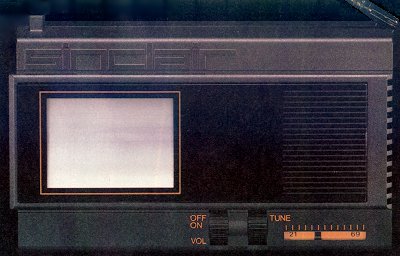

The idea of a portable television set small enough to fit into a pocket has been with Clive Sinclair for well over a decade, but his dream only recently became a reality, available in High Street shops nationwide in the last six weeks. Clive Sinclair began work on the pocket TV in the mid seventies. The project finally came to fruition in late ’83, £4 million-worth of development later, when the Sinclair Flat Screen Pocket TV became available by mail order, on a very limited basis. Now you should be able to pick one up from your local store for a fraction under £100.
In 1977 Sinclair launched a ‘pocket’ TV, which could be fitted into a pocket, but you had to have a very large pockets indeed — not just to fit the television into, but to take the £200 it cost out of! (about £500 in today’s money). The following year the Microvision appeared, and although the price was halved, it wasn’t a winner and the Sinclair small TV quietly disappeared from viewing.
Development work went on behind the scenes however, and the team at Sinclair developed a highly complex chip which could control all the routine functions of a cathode ray display — monitoring video and audio inputs, checking picture hold and maintaining the balance between brightness and contrast. This chip is at the heart of the Sinclair flat screen TV, handling the processes which produce the picture on its two inch screen.
While other companies developing small TVs have explored the possibilities of using liquid crystal displays — essentially those used on digital watches — and gas plasma displays, Sir Clive has always been committed to cathode ray tube technology.
Sinclair had to develop a new version of the cathode ray tube in order to make a flat screen TV, and the end result, incorporated into the Pocket TV provides a brighter picture, uses much less power and has half the volume relative to screen size to that of conventional cathode ray TV tubes.
In an ordinary domestic TV, a beam of electrons is fired from a ‘gun’ at the back of the cathode ray tube, through a vacuum, towards a phosphor coating on the inside front surface of the tube. When a point on the phosphor coating is hit by the electron beam, it emits light, and the image is built up on the screen as the beam scans lines across the phosphor coating, moving down a fraction at the end of each scan before starting the next.
A mini-screen TV using a conventional cathode ray tube would be difficult to fit into your pocket as it has to be comparatively thick to allow the gun to be at the back of the tube, firing forwards.
The Sinclair flat-screen TV cunningly has the electron gun at the side of the screen, firing electrons at right angles to the plane of vision. And the phosphor coated screen is at the back of the tube, not the front.
Enough of the technical details, how does the Sinclair Flat Screen TV perform? In Ludlow, where there are all sorts of TV reception problems, not terribly well — but it provides a better picture than the one the colour portable in the office can manage using its own aerial. The Sinclair TV has a telescopic transistor radio type aerial, which needs to be fully extended to pick up a decent signal, and the telly is very sensitive to its position — a couple of inches movement can make all the difference to the quality of the reception. With a bit of fiddling about, it proved possible to get a reasonable picture without too much grief. In a longer test, which involved our review model travelling to London, it performed very well. Our software editor managed to watch two complete films on it, and caught Barry Norman’s Film 85 in a motorway service station!

No, you can’t plug a computer into the Pocket TV; it doesn’t have an aerial input socket which is a bit of shame — it would have been handy to have been able to plug the flat screen TV into a more meaty aerial, perhaps the one on the roof for bedtime viewing . . . but then again, it is meant to be pocketable and you could buy a cheaper black and white telly for your bedroom.
The picture resolution is fine — with a little effort it proved quite possible to read the information on the Ceefax and Oracle pages broadcast in the morning, and while ‘Star Wars’ might lose some of its impact on a two inch screen, for most purposes the size of the picture is fine — you’re supposed to watch close up anyway.
Two controls are provided on the front panel: an on/off volume knob and a tuning knob which moves a linear pointer. Tuning is simple, just like on your faithful tranny but there’s a picture too! While the sound quality isn’t HiFi, it’s perfectly acceptable and with the earphone provided, totally private viewing and listening is possible.
For an extra £7.95 a mains adaptor is available mail order from Sinclair, which would be a worthwhile investment if you plan to watch much mini-telly indoors. The batteries used to power the set are flat lithium packs which have a life of some 15 hours continuous goggling, but they weigh in at £10 for a pack of three — could get a bit expensive.
Overall the Pocket TV is a smashing little device, and for £100 is not earth shatteringly expensive. It is genuinely tiny and light. Carrying it in an inside jacket pocket is no problem — if anything it’s easy to forget it is there — and the TV weighs less than many portable stereos.
Without doubt, portable TVs will catch on and may well be available in full colour before too long. Sir Clive’s Flat Screen TV is an excellent product, a lot of fun to have and use, and while far from essential in daily life, much more than a toy.
Apart from allowing you to watch your favourite programmes virtually anywhere, there are a host of applications for such a device. It could, for instance, bring a whole new dimension to watching live sport — you could have the best of both worlds by taking your pocket TV into the stands at a football match which is being televised. Action replays on the terraces no less!